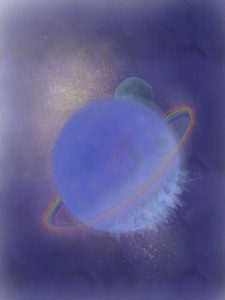
From the very first extra solar planet discovered, a hot Jupiter, to the most recent discoveries of intricate systems of Earth-sized planets, the field of exoplanetary sciences has challenged our preconceptions of how planets may form and evolve. Planetary consequences is an exercise designed to encourage our imaginations to break free of a geo-/solar-/anthropo-centric view of planetary systems, and to try and conceive of some of the wealth of possible evolutionary paths planets may have taken.
The idea of the game is through our imaginations to ‘model’ a planet’s history from the formation of its star system and planets through to a planet’s climate history and geological evolution. The exercise is designed to generate highly stochastic planetary history and, more importantly, absurd results. Just let your imagination and creativity guide you.
Planetary consequences is based on the game of consequences. A story is constructed by each person or group in turn writing a short narrative for part of a planet’s history, then passing the ‘paper’ (or spreadsheet) to another group to fill in the next part of the history. Importantly, you hide the section you have just written so that the subsequent group is completing the next phase of the planet’s history blind to what came before. This nicely captures the stochasticity (and perhaps chaos) of planetary evolution.
The game could be split into as many phases as desired, we will run the game with four stages [click here for a pdf slide, and here for a handout with a list of the sections]:
- A star is born
- Your planet coalesces
- Climatic conditions
- Geological history
An example planetary history constructed at UKEXOM 2017 is below.
When the universe was still young, a non-galactic tiny star system was born.
The total system mass was just 18 Msol.Then a big (mean) planet was born, with a ton of moons.
It had lots of rings too, and they had all the colours of the rainbow.
The millions of ice crystals made it glitter in the night sky, a beauty to behold.
It had a rotation period of 1hr.This planet was a water world, with a huge ice cap on its right side.
High altitude hazes filled the sky.
The day side was hot, and there was steam everywhere.The planet was impacted by its moon, multiple times.
UK exom 2017
It migrated from 0.1 to 250 au and then settled down at 1 au.
This planet is just 100,000 years old.
And life finds a way.